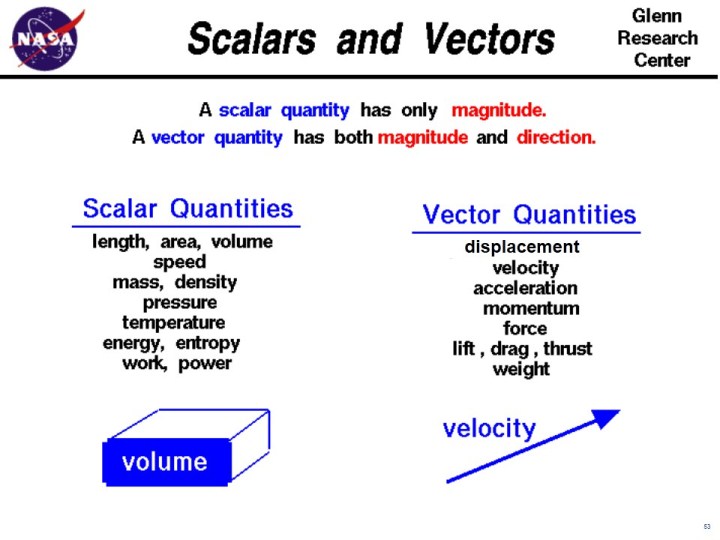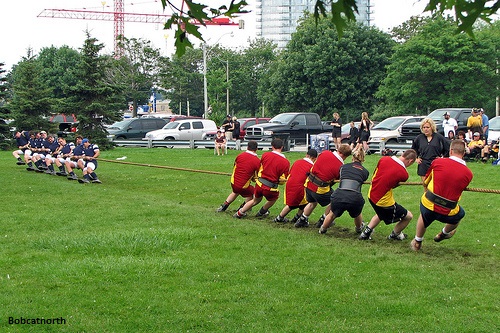HELP: Original Lessons on Forces
| Site: | Mountain Heights Academy OER |
| Course: | Physics Q4 |
| Book: | HELP: Original Lessons on Forces |
| Printed by: | Guest user |
| Date: | Friday, 1 August 2025, 3:39 AM |
Description
These are the lessons on forces from Q1. Review as needed.
Vector and Scalar Quantities
Watch the following description of vectors & scalars:
So in other words...
Scalar Quantities
When we talk about quantities being scalar we are talking about a quantity that only requires a magnitude. Magnitude is simply a fancy word used to describe the size of something. In fact magnitude and size could be considered synonyms to each other. One hint for recognizing a scalar quantity is that it is represented by a number only.
Vector Quantities
When we talk about quantities being vectors we are talking about a quantity that require BOTH a magnitude and direction. The vector quantity must always have a direction. This direction can be measured in many different ways. To indicate direction we can use compass coordinates (north, south, east, west), angles (90 degrees…), right, left, up, or down. Vectors are often represented by arrows. The size of the arrow represents the magnitude of the vector. The direction of the vector is indicated by the direction the arrow is pointing.
The following table lists examples of scalar and vector quantities.

https://www.grc.nasa.gov/www/k-12/airplane/vectors.html
Introduction to Forces
Force is defined as a push or pull acting on an object. There are several fundamental forces in the universe, including the force of gravity, electromagnetic force, and weak and strong nuclear forces. When it comes to the motion of everyday objects, however, the forces of interest include mainly gravity, friction, and applied force. Applied force is force that a person or thing applies to an object.
>
Q: What forces act on Carson’s scooter?
A: Gravity, friction, and applied forces all act on Carson’s scooter. Gravity keeps pulling both Carson and the scooter toward the ground. Friction between the wheels of the scooter and the ground prevent the scooter from sliding but also slow it down. In addition, Carson applies forces to his scooter to control its speed and direction.
Force and Motion
Forces cause all motions. Every time the motion of an object changes, it’s because a force has been applied to it. Force can cause a stationary object to start moving or a moving object to change its speed or direction or both. A change in the speed or direction of an object is called acceleration. Look at Carson’s brother Colton in the figure to the left. He’s getting his scooter started by pushing off with his foot. The force he applies to the ground with his foot starts the scooter moving in the opposite direction. The harder he pushes against the ground, the faster the scooter will go.
How much an object accelerates when a force is applied to it depends not only on the strength of the force but also on the object’s mass. For example, a heavier scooter would be harder to accelerate. Colton would have to push with more force to start it moving and move it faster. You can explore the how force, mass, and acceleration are related by doing the activity at this URL: http://www.harcourtschool.com/activity/newton/
Q: What units are used to measure force?
A: The SI unit for force is the Newton (N). A Newton is the force needed to cause a mass of 1 kilogram to accelerate at 1 m/s2, so a Newton equals 1 kg ∙ m/s2. The Newton was named for the scientist Sir Isaac Newton, who is famous for his laws of motion and gravity.
Force as a Vector
Force is a vector, or a measure that has both size and direction. For example, Colton pushes on the ground in the opposite direction that the scooter moves, so that’s the direction of the force he is applies. He can give the scooter a strong push or a weak push. That’s the size of the force. Like other vectors, a force can be represented with an arrow. You can see some examples in the figure below. The length of each arrow represents the strength of the force, and the way the arrow points represents the direction of the force.
Q: Can you think of a situation that might be represented by the forces in example 1?
A: One possibility is a toddler pulling on a wagon, being "helped" by an adult pulling on the same wagon. The toddler's pull would be force A, and the adult's pull would be force B. Both would contribute to the acceleration of the wagon.
Q: Can you think of a situation that might be represented by the forces in example 2?
A: One possibility is two sumo wrestlers pushing against each other at the start of a match. They're pushing against each other with equal-sized forces, so it's almost like the forces "cancel out" and they will not move.
Watch the following videos about forces:
Summary
- Force is defined as a push or pull acting on an object. Forces include gravity, friction, and applied force.
- Force causes changes in the speed or direction of motion. These changes are called acceleration.
- The SI unit for force is the Newton (N).
- Force is a vector because it has both size and direction. Like other vectors, it can be represented by an arrow.
Vocabulary
Review (questions you should be able to answer)
Types of Forces
Watch the following video on types of forces:
Free-body Diagrams
Free-body diagrams are the simplest way to represent a situation in physics. Here are a few guidelines to drawing them:
- The object that we're talking about is drawn as a box.
- All forces are drawn as arrows that start at the center of the object.
- Length and direction of the arrow represent size and direction of the force.
- All forces are labeled with their type, and sometimes with their magnitude.
Here are some common abbreviations that people use for the different forces:
- Gravitational force, or weight, is written
- Normal force is written
- Tension is written
, or sometimes just T
- Friction is written
Watch the following video to see some examples of free-body diagrams:
Net Force

The picture above may look like just another game of tug-of-war but when we look at this picture through the lens of physics we discover that there is a tremendous amount of physics involved. We will use this example of tug-of-war in this section to help us understand the physics concept of net force.
Net Force
A force is a push or a pull. Net force is the combination of forces that are acting on an object. In other words, net force is a combination of all the pushes and pulls that are acting on an object. In more scientific terms, we would define net force as the resultant vector or the vector sum.
When dealing with net force it is important to remember that forces are vectors. This means that we need to keep track of both the magnitude and the direction. There are two main methods that can be used to keep track of the direction of the force. The first method is to use vector arrows. When using vector arrows the direction the arrow is pointing is the direction of the force. The image below illustrates this concept. You can see that the first force has a magnitude of 40 N and the direction is to the right. The second force has a magnitude of 20 N and the direction is to the left.
The second method used to indicate the direction of the force is to use positive and negative signs (+, -) in front of the magnitude (size or value) of the force. In the example below we see the same forces as in the previous example but now the direction of the forces are indicated using the positive and negative signs.
Calculating Net Force
When forces are operating parallel to each other, we say that they are operating along a straight line. We can find the net force for parallel forces by adding up all of the values. In equation form it would look like this: Net Force = (Force 1) + (Force 2). In the example below we see that the magnitude of each force is 20 N. However the directions of the forces are opposite. The equation for this calculation will look like this: Net Force = (-20 N) + (20 N). When we do the math we find that the net force is equal to zero.
When forces are operating at an angle that is not parallel we need to use vector math. Below are several videos that will teach you graphical methods for solving vector math.
Geometric Vector Operations
Adding Vectors Graphically
Subtracting Vectors Graphically
Scalar Multiplication of Vectors Graphically
Finish this lesson by watching this video of review and examples: